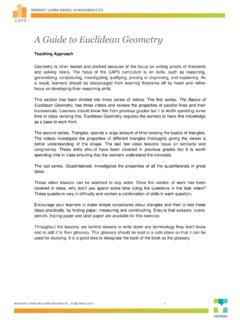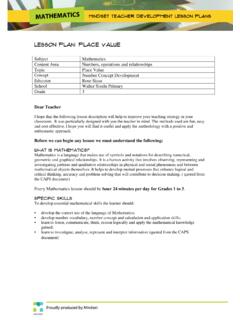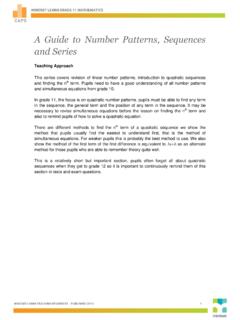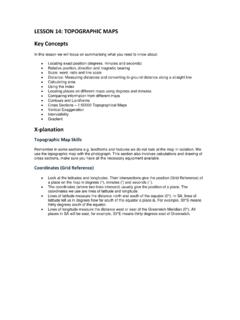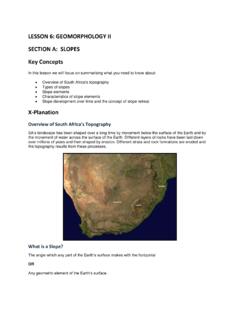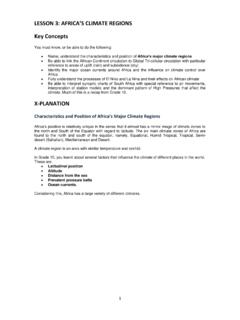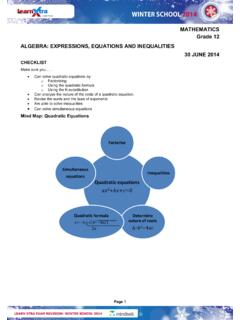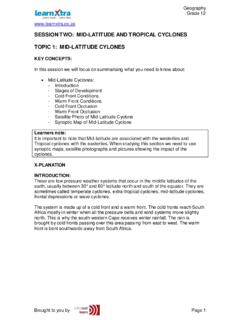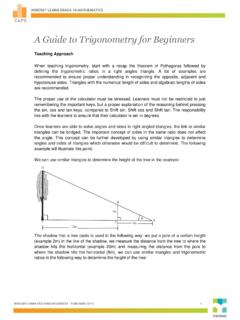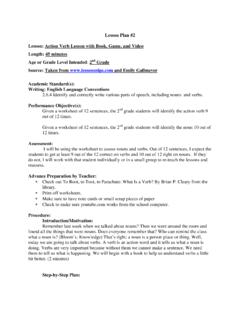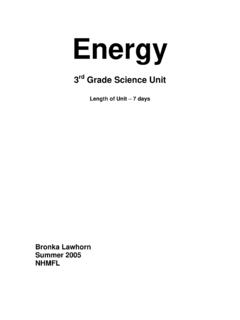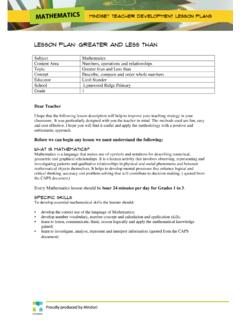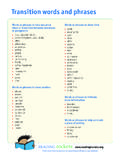Transcription of LESSON PLAN: Symmetry - Mindset Learn
1 LESSON plan : Symmetry Dear Teacher I hope that the following LESSON description will help to improve your teaching strategy in your classroom. It was particularly designed with you the teacher in mind. The methods used are fun, easy and cost effective. I hope you will find it useful and apply the methodology with a positive and enthusiastic approach. Before we can begin any LESSON we must understand the following: What is Mathematics? Mathematics is a language that makes use of symbols and notations for describing numerical, geometric and graphical relationships. It is a human activity that involves observing, representing and investigating patterns and qualitative relationships in physical and social phenomena and between mathematical objects themselves.
2 It helps to develop mental processes that enhance logical and critical thinking, accuracy and problem-solving that will contribute to decision-making. ( quoted from the CAPS document) Every Mathematics LESSON should be 1hour 24 minutes per day for Grades 1 to 3. Specific Skills To develop essential mathematical skills the learner should: develop the correct use of the language of Mathematics; develop number vocabulary, number concept and calculation and application skills; Learn to listen, communicate, think, reason logically and apply the mathematical knowledge gained; Learn to investigate, analyse, represent and interpret information( quoted from the CAPS document)
3 Subject Mathematics Content Area Space and Shape Topic Symmetry Concept Recognise and draw line of Symmetry in 2-D geometrical and non geometrical shapes Determine line of Symmetry through paper folding and reflection Educator Nontobeko Sibiya School Irene Primary School Grade 3 Weighting of Content Areas in Foundation Phase Weighting of Content Area Time Grade 1 Grade 2 Grade 3 Time per week Numbers, Operations and Relationships* 65% 60% 58% 120 minutes Patterns, Functions and Algebra 10% 10% 10% 80 minutes Space and Shape (Geometry) 11% 13% 13% 80 minutes Measurement 9% 12% 14% 80 minutes Data Handling (Statistics) 5% 5% 5% 60 minutes Note: This LESSON plan is only part of an entire daily Mathematics LESSON .
4 You should include as part of this LESSON plan . Counting Mental Mathematics Consolidation of concepts Problem Solving Group work Independent Activities Content Area Topic Concept and skills for the year Grade 1 Concept and skills for the year Grade 2 Concept and skills for the year Grade 3 Space and Shape Symmetry Recognise Symmetry in own body. Recognise and draw line of Symmetry in 2-D geometrical and non-geometrical shapes Recognise and draw line of Symmetry in 2-D geometrical and non-geometrical shapes Recognise and draw line of Symmetry in 2-D geometrical and non-geometrical shapes. Determine line of Symmetry through paper folding and reflection Apparatus 1.
5 Cardboard shapes 2. mirrors 3. activity sheets Definition Symmetry : Symmetry is when one shape becomes exactly like another if you flip, slide or turn it. The simplest type of Symmetry is "Reflection" (or "Mirror") Diagonal Line: Horizontal Vertical Teaching Method Discuss shapes and their names. Use this as an opportunity to do revision on 2D geometrical shapes. ( integration with literacy - word recognition ) Use these shapes to show the symmetrical lines. These symmetrical lines are indicated as a dotted line on the varies 2D shape Introduce the terms: Horizontal lines / Vertical line / Diagonal line.
6 Show these lines on the shapes. Diagonal Line Horizontal Line Vertical Line Explore Symmetry using mirrors. Give each learner a mirror and a picture which is half done. Let them put the mirror on the line of Symmetry to discover the rest of the picture. Allow them to complete the picture with a koki. Let the learners complete a few activities where they have to complete a picture. Walk around to ensure that the learners are doing the activity correctly. Explain Symmetry by doing the folding test. Prepare your paper before the time. Use colour paper if it is possible.
7 Folding Test ( ) You can find if a shape has a Line of Symmetry by folding it. When the folded part sits perfectly on top (all edges matching), then the fold line is a Line of Symmetry . Here I have folded a rectangle one way, and it didn't work. So this is not a Line of Symmetry But when I try it this way, it does work (the folded part sits perfectly on top, all edges matching): So this is a Line of Symmetry Triangles A Triangle can have 3, or 1 or no lines of Symmetry : 3 Lines of Symmetry 1 Line of Symmetry No Lines of Symmetry Quadrilaterals Different types of Quadrilaterals (a 4-sided plane shape).
8 Square Rectangle Irregular Quadrilateral 4 Lines of Symmetry 2 Lines of Symmetry No Lines of Symmetry Show them how to cut out a butterfly and then how to cut out symmetrical shapes using colour paper. They will use these to decorate the butterfly. Circle A line (drawn at any angle) that goes through its centre is a Line of Symmetry . So a Circle has infinite Lines of Symmetry . Square Once you have completed the folding activity give each child a square piece of paper and let them explore how many lines of Symmetry a square has. Count the lines with the class. There should be 4 lines of Symmetry .
9 Draw each line in a different colour. Sorting: Give the learners a set of shapes which are non-symmetrical and symmetrical. Allow them to sort out these shapes Butterfly: Practical Application: Let the learners use geometric shapes to build symmetrical pictures. Ask them to show you where the line of Symmetry is. References.
